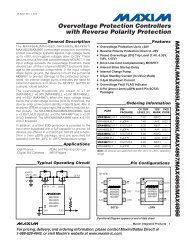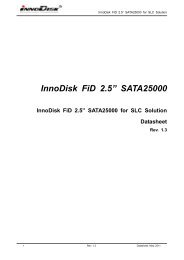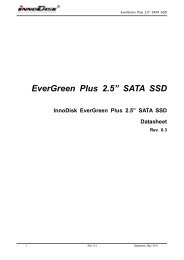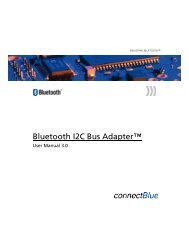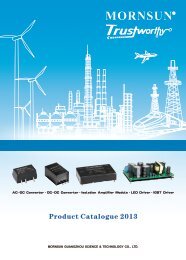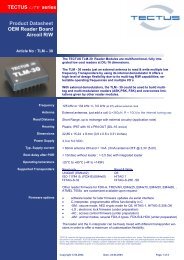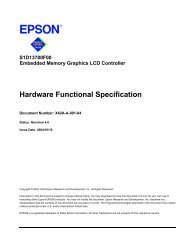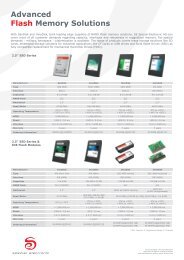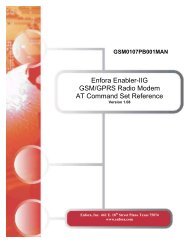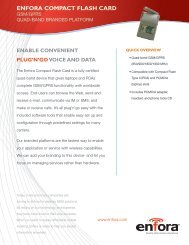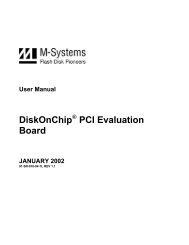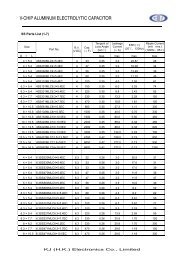Enabler II-G Assiste GPS Integration Guide - Farnell
Enabler II-G Assiste GPS Integration Guide - Farnell
Enabler II-G Assiste GPS Integration Guide - Farnell
Create successful ePaper yourself
Turn your PDF publications into a flip-book with our unique Google optimized e-Paper software.
Enfora <strong>Enabler</strong> <strong>II</strong>I-G<br />
Modem <strong>Integration</strong> <strong>Guide</strong><br />
9. Software Interface<br />
9.1. Software Interface<br />
The application sends commands to the Enfora <strong>Enabler</strong> <strong>II</strong>I-G module via the 100-pin I/O signal<br />
connector. These commands use the Enfora AT Command Set and/or Enfora’s Packet API.<br />
The Enfora <strong>Enabler</strong> <strong>II</strong>I-G module operates in one of the following modes:<br />
• Command mode: Used for configuring the Enfora <strong>Enabler</strong> <strong>II</strong>I-G module, for interrogating the GSM<br />
network, and for placing and receiving calls. It uses the AT command set via the serial port for<br />
communication.<br />
• On-line mode: Used after a circuit-switched data call has been established. Data is passed<br />
between the Enfora <strong>Enabler</strong> <strong>II</strong>I-G module and the controlling application without command<br />
interpretation. The only AT command that is interpreted in On-line mode is the +++ command.<br />
(This command places the Enfora <strong>Enabler</strong> <strong>II</strong>I-G module in Command mode but does not<br />
terminate the circuit-switched data call.)<br />
• IP Packet /API Mode: Used to read/write modem parameters, interrogate network information,<br />
and place and receive calls in real-time, multi-tasking mode. The Packet API mode is facilitated<br />
over a PPP connection and the packets can be constructed according to the information provided<br />
in the Enfora GSM-GPRS Family API Reference GSM0102PB002MAN. Enfora GSM-GPRS<br />
Family Modem Control Library Reference GSM0000PB006MAN provides detail of the UDP<br />
Modem Control Library that has three levels: port, messaging, and modem libraries. Each of the<br />
three levels contains one or more libraries. For example, the port libraries layer has UDP PPP<br />
Port, UDP Socket Port, and COM Port libraries. All libraries are provided as a part of the Enfora<br />
<strong>Enabler</strong> <strong>II</strong>I-G Module <strong>Integration</strong> Toolkit.<br />
The AT command driver of the Enfora <strong>Enabler</strong> <strong>II</strong>I-G module never exits the Command state, that is, it<br />
never enters the On-line mode. Although the host interface may not be able to access the AT<br />
command interpreter, it is always running and is available via the API Mode over a PPP connection<br />
and/or via the RF interface.<br />
• In the Command state, characters that are received from the Customer Premise Equipment<br />
(CPE) are treated as AT commands by the Enfora <strong>Enabler</strong> <strong>II</strong>I-G module.<br />
• In response to the commands received from the CPE, the Enfora <strong>Enabler</strong> <strong>II</strong>I-G module sends<br />
characters (AT commands) to the CPE.<br />
• Various events can also trigger the Enfora <strong>Enabler</strong> <strong>II</strong>I-G module to send characters (AT<br />
commands) to the CPE.<br />
GSM0308PB001 68 Version 1.03– 7/17/2007



